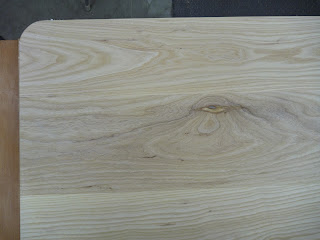My soap froth was a little more concentrated than Reed's. I threw a couple handfuls of flakes into about a 1/4" of water, Reed uses one handful. I came to a nice finish after 2 coats, Reed says he normally does four minimum. With the amount of sanding between coats and soap dust I was happy with two coats.
I sanded between each coat, 220 on the first, 320 on the second, then buffed all surfaces with a white 3m pad.
The table top after a couple coats:
Making table top clips:
All clips mortised and installed. The four outside visible clips were mortised to give a snug fit. For the others underneath the top, I sped things up with a pattern and template cutter on the plunge router.










This comment has been removed by the author.
ReplyDeleteSoap flakes is different but why not just a mineral oil finish. Does it leave a different feel.
ReplyDeleteThanks for the comment Ken, sorry just noticed it. Soap suits a wood like white ash. It keeps the colour closer to white. Oil on white ash can yellow over time. yes, slightly different feel, silky smooth to the touch.
ReplyDelete